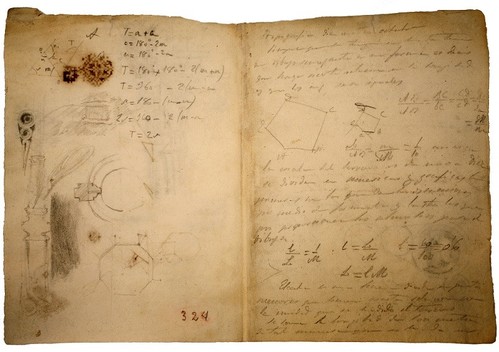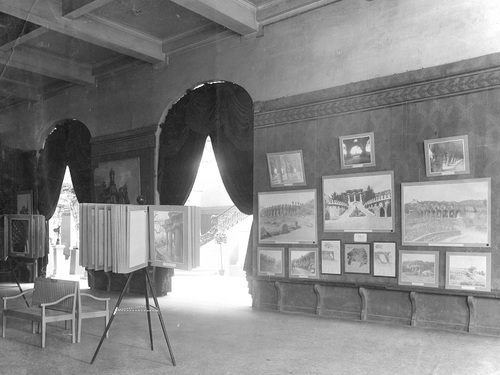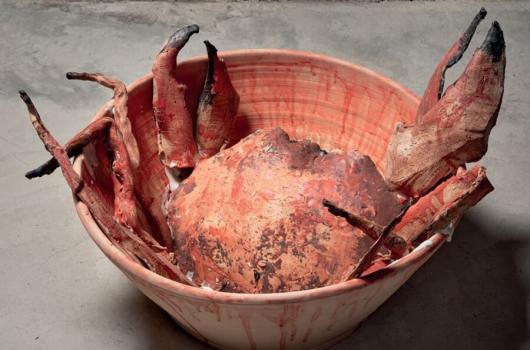Throughout his life, Antoni Gaudi was a close observer of nature, seeking rationality in its forms in order to extract from them their full potential and usefulness to construction.
Intuitive, reflective, tenacious and a perfectionist, he had a tremendously innovative spirit.
«The great masters are those whose sense has been served by an acute and powerful intelligence.» Antoni Gaudi
«Reflection and action need to alternate so that they can complement and correct each other.» Antoni Gaudi
Timeline
1852
Birth
Antoni Gaudi i Cornet is born on 25 June, the son of Francesc Gaudí i Serra and Antònia Cornet i Bertran. He is baptised the following day at Sant Pere Priory Church in Reus, the city where he spends his childhood.
His parents have four other children, Rosa, Maria, Francesc (who dies) and Francesc, named after his deceased older brother. Of all his parents’ offspring, Gaudi is the only one to live beyond 35 years of age.
1860
School
He begins his primary education at the school run by Berenguer in Reus. In 1863, he joins the Piarist school in Reus.
Berenguer is the father of Francesc Berenguer i Mestres, a great friend of Gaudi’s and his collaborator. In the early years of Gaudi’s secondary schooling, he receives poor marks in all subjects apart from geometry and 2 arithmetic, at which he excels. He receives a classical, religious and humanistic education.
1867
Drawings in El Arlequín
.jpg)
At the age of 15, Gaudi draws illustrations for the handwritten magazine El Arlequín.
Twelve copies are produced of each of the ten issues of the magazine published.
1869
Move to Barcelona
At the age of 17, he moves with his family to Barcelona and enrols at the Middle Education Institute as a pupil entitled to sit exams but under no obligation to attend classes.
He studies elements of physics and natural history. He registers at the University of Barcelona Faculty of Sciences, where he studies a foundation course in architecture with a view to entering the Provincial School of Architecture. During this period, he lives with his brother Francesc at number 12 on Placeta de Montcada, next to the Church of Santa Maria del Mar.
1870
Restoration project for Poblet Monastery
Together with his classmates Eduard Toda i Güell and Josep Ribera, he draws up a restoration project for the Monastery of Santa Maria de Poblet (Conca de Barberà).
Prior to this, the monastery had been abandoned and was in a very poor state of repair.
1873
Work on Ciutadella Park I Barcelona
To finance his studies, he works as a draughtsman for the master builder Josep Fontserè i Mestres.
At that time, Fontserè had been commissioned to develop Ciutadella Park. Gaudi worked on the design of the perimeter railings, the monumental waterfall, the balustrade around the monument to Carles Aribau and the cistern to 3 regulate the water supply. He continued to contribute to the park works until 1878.
1873
Manuscrit de Reus

This document is a collection of notes and sketches that Gaudi kept in a folder.
It also contains drawings for the pieces he did as preparation to enter the Barcelona Provincial School of Architecture. Written in the manner of a diary, it includes entries on the family home, the art of ornamentation, his personal work and his relationships with the teaching staff. The manuscript ends in 1877 with notes on a festive lunch with architects from the first year at the Provincial School of Architecture.
1873
Studies at the Provincial School of Architecture
Gaudi begins the admission courses at the Barcelona Provincial School of Architecture. In 1875, he passes the foundation course.
Notable projects from this period as a student include the gate to a cemetery (1875) and a jetty (1876).
1875
Projects as a student

Gaudi designs a number of projects for subjects taught at the Barcelona Provincial School of Architecture.
These projects include: a static calculation for the water cistern in Ciutadella Park (1875); a project for a general hospital in Barcelona (1876-1877); a project for the Spanish Pavilion at the World’s Fair in Philadelphia (1876); and a fountain for Plaça de Catalunya in Barcelona (1877). His end-of-course project is a design for a university auditorium (1877).
1876
The death of Antònia Cornet i Bertran
His mother dies, a loss that affects him deeply.
1876
Drawings for the Sanctuary at Montserrat
In his capacity as draughtsman for the architect Francesc de Paula del Villar i Lozano, he produces drawings for the apse and niche of Our Lady of Montserrat.
1878
Gaudi qualifies as an architect
On 15 March, he officially qualifies as an architect. On presenting Gaudi’s certificate to him, the director of the University of Barcelona School of Architecture, Elias Rogent, comments: “We have given this degree to a madman or a genius, time will tell.”
1878
Business card

His first business card as a professional, working out of number 11 on Carrer del Call in Barcelona.
1879
Member of the Catalanist Association of Scientific Excursions
On 29 April, he becomes a member of this association.
The association was founded three years earlier for people keen to go on outings of a cultural nature. During these excursions, the scientific and artistic qualities of the heritage site or monument visited were discussed.
1880
Exhibition of the Industrial Arts
Gaudi is a member of the organising committee of the Exhibition of the Industrial Arts.
This exhibition is held in December in the central offices of Foment del Treball Nacional (the main employers’ association) in Barcelona. In January 1881, Gaudi writes an article about the exhibition in Catalan, which is published in two instalments in La Renaixensa newspaper.
1882
Collaboration with the architect Joan Martorell
Gaudi works as an assistant draughtsman (undoubtedly sketching paintings for some vaults) for the architect Joan Martorell i Montells.
The architect was building the church of the Sagrat Cor de Jesús School on Carrer de Casp in Barcelona. Gaudi also works for Martorell on the Gothic Revival church of the Silesian nuns on Passeig de Sant Joan in Barcelona.
1883
Meeting of members of cultural excursion associations
He attends a meeting at Banyuls-sur-Mer of Catalanists on the Spanish and French sides of the border who are members of excursion associations.
At the event, held on 18, 19 and 20 June, the works of Àngel Guimerà, Narcís Oller and Artur Masriera are read. The participants also visit Perpignan and Elne, where photographs of the cloister are taken.
1906
Home in Park Güell and the death of Francesc Gaudi
He buys the Park Güell show house, built by Francesc Berenguer i Mestres, and moves into it with his father and niece. That same year, his father dies at the age of 93.
1910
Gaudi Exhibition in Paris

This exhibition is presented at the Salon of the Société des Beaux-Arts. To prepare the exhibits (models, plans and photographs of various works), Gaudi is helped by the architects Joan Rubió i Bellver and Francesc Berenguer i Mestres.
He is also assisted by the student of architecture Joan Bordàs i Salellas and the photographers Mas and Cuyàs. The exhibition is held between April and June in the Grand Palais with the patronage of Eusebi Güell, who invests a large sum of money in it. The exhibits, which are not officially in the Salon competition, are displayed in a room set aside for him. He receives plaudits from the critics for his work.
1911
Participation in the First National Architecture Salon in Madrid
At the First National Architecture Salon (Madrid), he shows the pieces produced expressly for the Gaudi Exhibition held the previous year in Paris.
Once the exhibition closes, the pieces are returned to Barcelona and installed in his studio at Sagrada Família. Most of them are lost in the fire of 1936.
1911
First will
Ill with brucellosis, he writes his first will while in Puigcerdà.
1912
The death of Rosa Egea i Gaudí
His niece dies at the age of 36.
Rather than remain on his own in the house in Park Güell, he decides thenceforth to live in the studio at Sagrada Família, where he spends the remaining years of his life.
1918
The death of Eusebi Güell i Bacigalupi
His patron and protector dies at the age of 71 in Casa Larrard in Park Güell.
1922
The Spanish Architects Congress is held in Barcelona
The Spanish Architects Congress is held in Barcelona. During the congress, support is given to Gaudi’s work, in particular the construction of Sagrada Família.
1926
Gaudí’s death following an accident in Barcelona
On 7 June, at the corner of Gran Via de les Corts Catalanes and Carrer Bailèn, he is hit by a number 30 tram and severely injured. He is 74 years old. He is taken to the Hospital de la Santa Creu, where he dies three days later.
On 12 June, his body is buried in the Carmel Chapel in the crypt of Sagrada Família. A throng of people gather to 7 mourn him.
Bibliography
BERGÓS, Joan: Gaudí, l’home i l’obra. Barcelona: Lundwerg, 1999.
CASANELLES, E. Nueva visión de Gaudí. Barcelona: Ediciones Polígrafa, 1965.
MARTINELL, Cèsar. Gaudinismo. Barcelona: Amigos de Gaudí, 1954.
MARTINELL, Cèsar. L’arquitecte Gaudí. Reus: Asociación de estudiós reusenses, 1979.
MATAMALA, J. Antonio Gaudí. Mi itinerario con el arquitecto. Barcelona: Editorial Claret, 1999.
PLA, Josep. Homenots. Barcelona: Ediciones Destino, 1969.
PUIG BOADA, I. El pensament de Gaudí. Barcelona: Col·legi d’Arquitectes de Catalunya, 1981.
RÀFOLS, J. F. Gaudí. Barcelona: Canosa, 1929; Barcelona: Aedos, 1952 i 1960.
RÀFOLS FONTANALS, J.F.: FOLGUERA, FRANCESC. GAUDÍ 1928. Barcelona: Universitat Politecnica de Catalunya, 2011.


